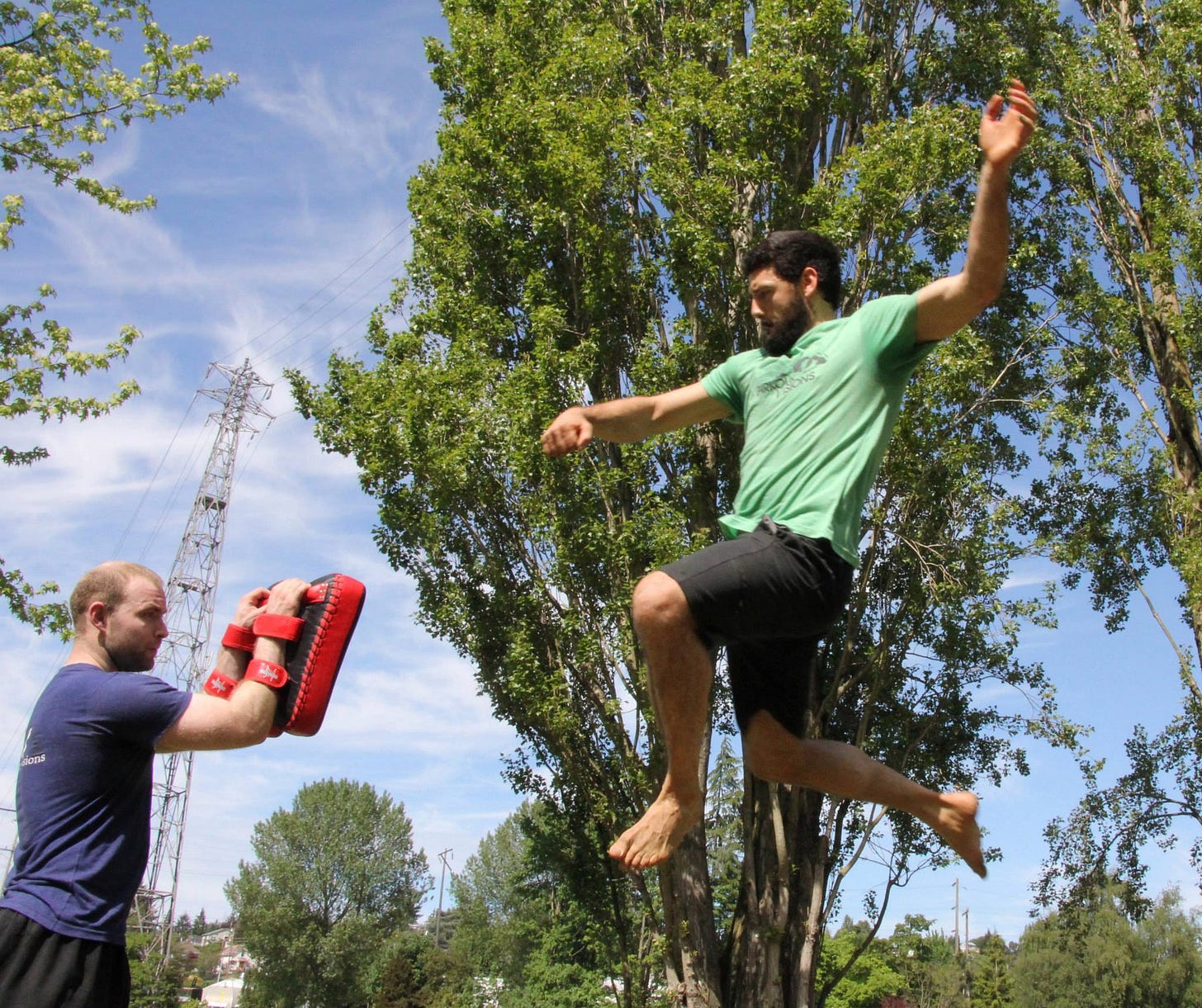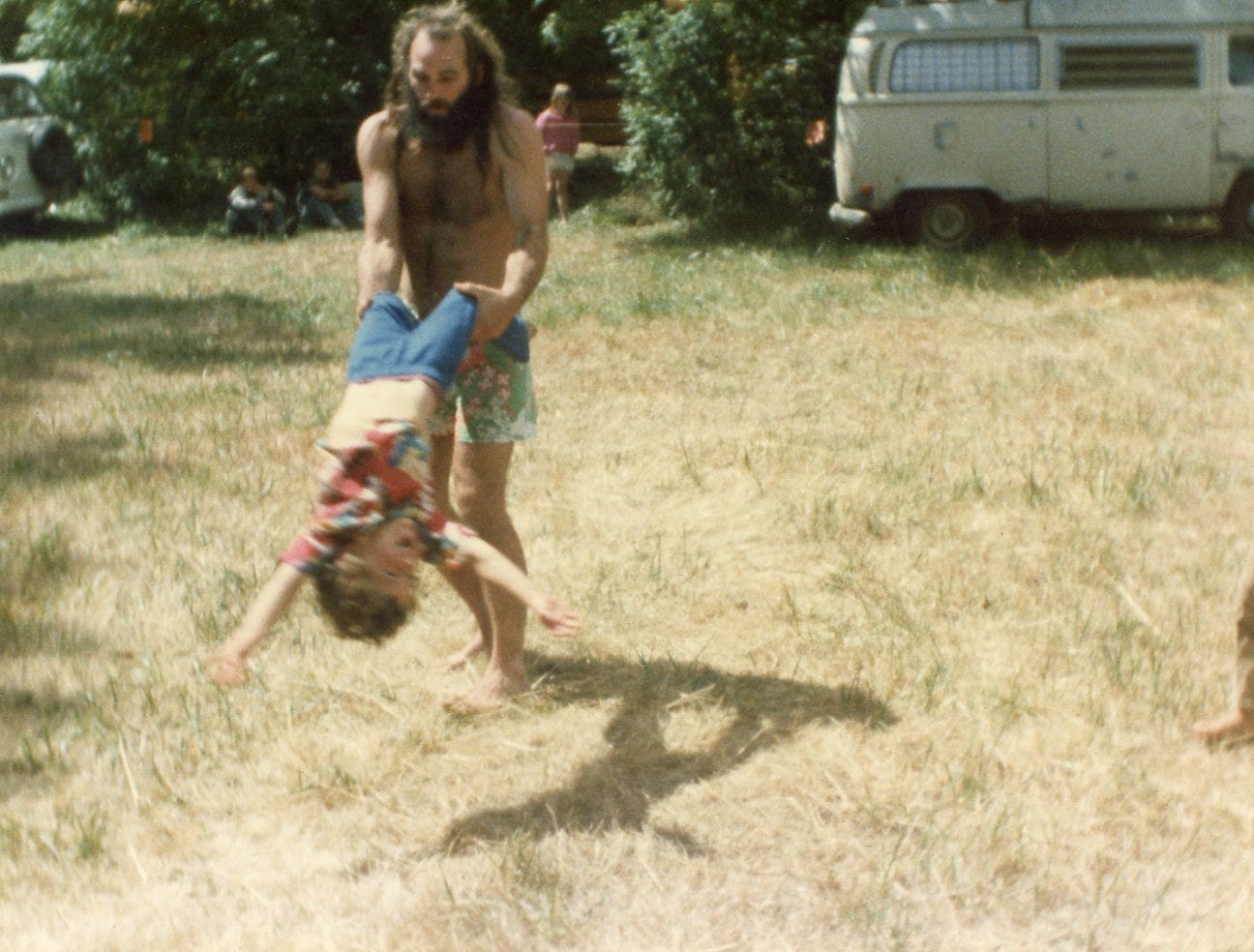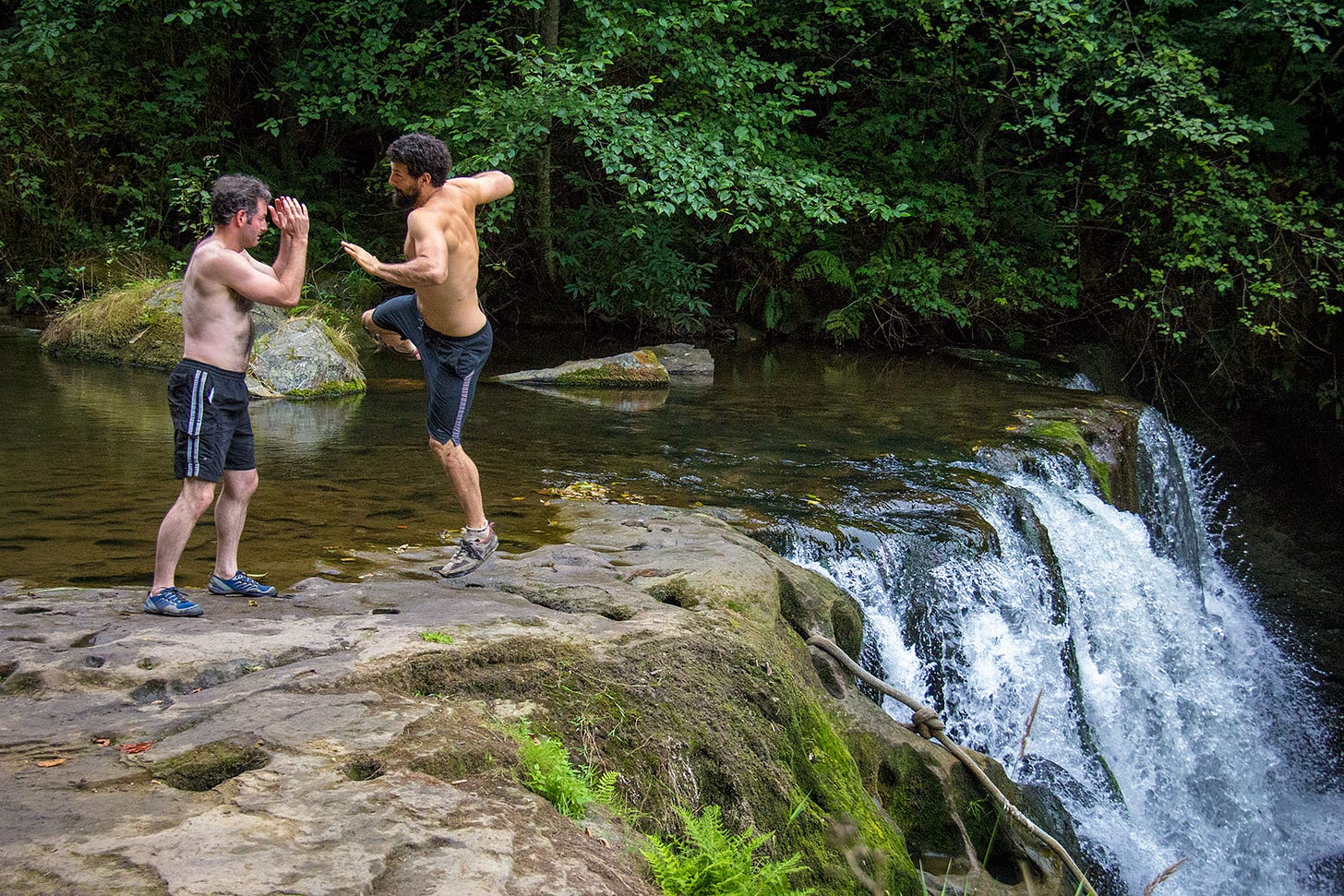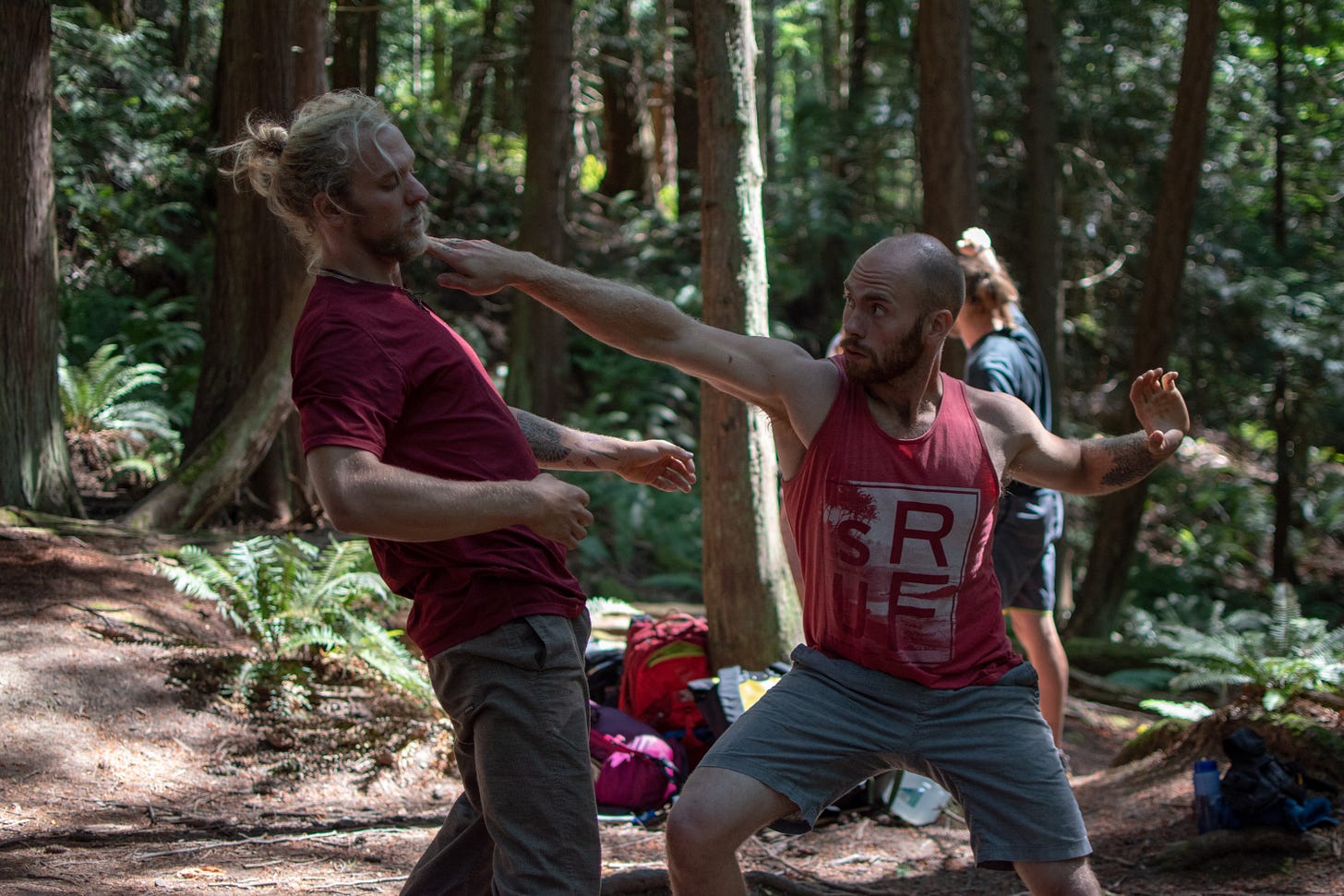One of the least successful experiments I ever made was trying to teach a self defense class at Parkour Visions (PKV), the parkour gym I had co-founded in 2009.
Picture the scene. In 2012 our team built a world class 10,000 square foot gym in Seattle to share our passion for parkour with the local community.
In the one flat corner of that gym a small group of students are trying out their first self defense class. They’re here less because of an interest in self defense and more out of loyalty to me as the lead parkour coach.
We line up and start by practicing footwork drills.
We slide forward, backwards, sideways, and on each diagonal. Practicing shuffling footwork & learning to step off the line of an attack.
Next we work on head movement and elbow blocks.
Then palm strikes and knee stomps.
I had spent months working with two other martial artists who were also parkour coaches to build up this curriculum. It was based on our shared backgrounds in Muay Thai, Brazilian Jiu Jitsu and Korean martial arts.
Conceptually it was framed around ideas learned from Rory Miller, Matt Thornton, Gavin De Becker and Geoff Thompson. Each movement we taught was carefully selected based on what we believed was the highest potential to be useful in a self defense situation.
All very serious, all very technical, nothing playful.
Meanwhile, all around us, other classes are laughing and having fun doing acrobatics, flying through the air, or working together to create fun new parkour routes.
It went over like a lead balloon.
As the weeks passed, the initial group of students slowly faded out, new students failed to join us, and eventually we had to cancel the class altogether. It turned out that the people who came to us for the fun of parkour were not super keen on diving deeply into the the dynamics and tedious mechanics of violence.
This was a bitter pill for me to swallow.
I had spent close to half my life training martial arts by this point, and since the earliest days of my parkour training in 2005 I had wanted deeply to develop a method and community that united the practices of parkour and martial arts.
Before PKV had been formed, I had been involved in an attempt to revive Methode Naturelle, the French antecedent of parkour, which had included self defense as a core aspect of the practice.
That project would eventually become what is now MovNat, and one of the areas I had butted heads with the founder Erwan about was the depth of martial arts training that would be central to the new method.
When Erwan and I taught the first MovNat seminar together at the Sunray Shire in 2008, I had insisted on bringing in my Muay Thai teacher and a former marine Tony Garcia to handle the martial arts coaching.
At the time, I felt that neither of us were quite ready to properly fill that role, but four years later I was sure I was ready to handle the martial arts instruction myself.
I had hoped to grow a community of generalist movers within parkour visions. My first attempt was an abject failure though; despite my technical knowledge and passion for the martial arts, I was simply unable to maintain the interest of the students we already had.
So I had to go back to the drawing board. I asked myself what if we could capture what people love about parkour in martial arts training. I had argued for years (along with my wife, who made it her masters thesis ) that parkour was in fact a form of play.
If that aspect of playfulness was bringing people into the parkour program, which it was, could I find a way to build an approach to martial arts utilizing the same underlying principle? The answer was obvious and nestled within another project that had been brewing in my mind, which was the question of how rough and tumble play could be taught and widely shared.
I had already seen some development in this direction from Frank Forencich’s Exuberant Animal method, but as I was considering this problem of a play based approach to martial arts, the biggest touch stone for me was actually my own experience growing up.
Roughhousing had been one of the most important recurrent themes of my childhood, starting with my relationship to my father, my older brother and my cousins.
As I’ve mentioned before, my father Sun Ray was a high school wrestler and collegiate football player. When I was young, he bonded with me and my siblings with lots of roughhousing. He was well known for lifting us all the way over his head and flying us around like airplanes when we were infants.
As we grew bigger he loved lifting, throwing and swinging us around. As a young child I was surrounded by other kids in a small community and all of us were given a great deal of freedom to play, which means we did a ton of roughhousing.
Later in my childhood I had an important mentor named Gopal who roughhoused with me daily for several years. Roughhousing with Gopal would help me through some of the most difficult moments of my childhood.
During my early school years I was dealing with the simultaneous traumas of struggling with ADHD and Dyslexia, my Fathers neglect due to being unable to handle my academic struggles, my older brother moving to California to be with his biological father, and my parents marriage starting to erode.
This regular access to rough and tumble play combined with more formal martial arts training helped me learn to stop acting out violently.
With this experience I recognized very early in life that roughhousing was something I needed.
Furthermore I began to see that there was a huge craving for it in many of the children around me. I started being asked to babysit at 12 years old because I was already proving adept at entertaining younger kids through roughhousing. In my late teens I became a mentor for at risk youth, and again I found rough and tumble play was the best way I could help the kids I worked with.
When I became a gymnastics coach in my early 20’s, my willingness to roughhouse became a great way to bond with my students that provided a major outlet for their out of control energy. It helped me get them to focus on building skills.
Over and over throughout my life I saw the power of rough and tumble play. Even so, in my zeal for self defense I had left the play aspect completely behind while building the first martial arts curriculum for PKV.
As 2012 turned into 2013, I was strongly advocating for an overall emphasis on play and natural movement at the gym, but unfortunately this was not resonating with all of the staff.
We would attempt one more experimental roughhousing class, but at this time it was becoming clear I would be stepping away from my position as head coach, so we shut it down.
As my path split from PKV’s, I turned my energy to creating what would become Evolve Move Play.
So it was at the first Return to the Source back 2013 that I first integrated roughhousing as a play based martial arts practice within my overall movement approach, and it would be a huge improvement.
Roughhousing became one of the core features of Evolve Move Play seminars, something that was almost completely unique to what we did at that stage.
In those early years of Evolve Move Play, as I was trying to map an overall approach to movement that was rooted in an evolutionary understanding of human beings, I also began to experiment with Dance.
I took local capoeira and contemporary dance classes and learned from other emerging movement teachers. Over time I came to see how these arts could be integrated into the overall roughhousing practice to produce a much more adaptable overall movement capacity.
What I and my students were developing was convergent with a number of other evolving movement approaches which emerged around the same time.
Ido Portal would utilize partner games that were rooted in his background in Capoeira, Boxing and other martial arts, and integrate them into his approach to movement culture.
Simon Thakur’s Ancestral movement would similarly integrate aspects of capoeira, internal martial arts, Brazilian Jiu Jitsu and various wrestling traditions.
Fighting Monkey’s Jozef Frucek and Linda Capetana would bring ideas from dance and martial arts together as a major aspect of their practice.
Bruno Caverna would debut his play-fight approach, and Tomislav English would integrate aspects of martial arts and dance in his Ferrus Anima approach.
Tom Weksler & Shira Yaziv would study contact improvisation and ecstatic dance and bring those into conversation with Capoeira and Brazilian Jiu Jitsu(Tom) and contemporary dance more broadly.
Most importantly for us, Aaron Cantor, who would go on to collaborate with me on Evolve Move Play and is now one of our head coaches, was developing his own ideas of interactive games.
His search was for an Asana of communication that answered the questions left unanswered by his yoga practices. He developed his games in part through study of contact improvisation, the Russian martial art Systema, theater and capoeira.
All of us would meet, & cross pollinate material over the years. I have met and learned from everyone on that list except Bruno, and all have learned directly from me as well save for Bruno, Fighting Monkey and Ido.
As the interactive movement practices spread in the growing movement culture, I took pride in our unique role in propagating these practices. Specifically I believe more than anyone else I was doing the research on the scientific study of play and its evolutionary origins. I also believed I had the deepest background in combat sports and most advanced individual skill in that arena.
I kept my approach directly connected to martial arts & self defense and made sure to point back to my sources there.
What Aaron has brought is deeper appreciation for how roughhousing can be valuable without any specific desire to develop combative skill. Aaron has also spent thousands of hours working on how roughhousing can be scaled down to work for any level of student.
I am incredibly excited to be able to say that we at Evolve Move Play are the first to offer roughhousing as an online course, with our Roughhousing 101 program set to release in January.
This has been a goal since we debuted our natural parkour courses in 2019. However the base of games I was using at the time would have been hard to translate to the online world without Aaron contributions.
Now we have a foundation that we’ve mutually built that provides an exceptionally approachable entry point for anyone who wants to implement these practices into their own life.
With this program in place we have a scaffolding for further and deeper explorations of roughhousing, branching into combative, dance, team sport, partner acrobatics, and embodied communication skills.
Already we have built two expansion courses titled Roughhousing for Teachers and Parents, and Roughhousing for Intimate Couples, that applies the concepts, games and practices presented in our Roughhousing 101 course to facilitate playful meaningful movement with kids as well as romantic partners.
Most importantly they are a foundation for skillfulness in the metagame of life.
You can join the presale for this course for just 2 more days by clicking the link provided below.
Evolve Move Play Black Friday Roughhousing Deal
Right now we’re running a Black Friday deal for 50-70% off, but after this pre-sale ends, you will still be able to pick up the course when we open sales again at full price sometime in January of 2024.






